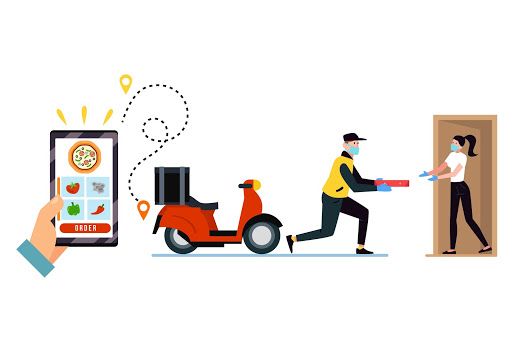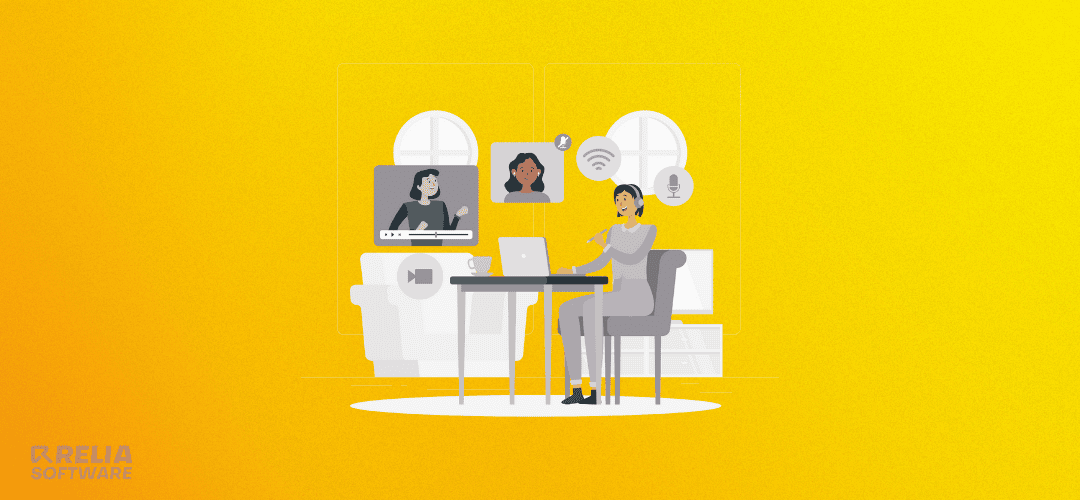On-demand delivery services have become popular for retailers to ameliorate customer satisfaction and contend with other businesses. These services allow guests to order products online and have them delivered to their doorstep or picked up at a nearby store within a short time.
With further guests shopping online and using mobile devices to make purchases, retailers have had to acclimatize to changing consumer preferences and offer brisk and more accessible delivery options. In this environment, on-demand delivery services have surfaced as a way for retailers to meet these prospects and give a further flawless shopping experience. So, how will on-demand delivery services impact retail stores?
>> Read more: Top 10 Best Mobile Applications for Logistics Companies
Advantages of On-Demand Delivery Services in Retail Stores
Convenience for customers: The ease of shopping from home and having their goods delivered to their doorstep or picked up at a near position is handed by on-demand delivery services. They can cover themselves at any hour of the day or night thanks to the time and trouble savings.
Increased foot traffic to physical stores: On-demand delivery services can also increase bottom business to physical stores, as guests may choose to pick up their orders in person rather than stay for them to be delivered. This can lead to fresh deals and openings for retailers.
Faster delivery times for in-store pickup: With on-demand delivery services, retailers can prepare orders ahead of time and have them ready for guests when they arrive at the store. This can lead to brisk delivery times and a more flawless shopping experience.
Competitive advantage: Offering on-demand delivery services can give retailers a competitive advantage over other businesses that don't offer this service. It can help attract new guests and retain being bones by furnishing a more accessible and satisfying shopping experience.
Increased deals for retailers: On-demand delivery services can lead to increased deals for retailers, as guests may be more likely to buy if they know they can admit it snappily and accessibly. This can also lead to reprise business and increased client fidelity.
Improved inventory management: With on-demand delivery services, retailers can manage their force by having a better idea of what products are in demand and when. This can help them avoid overstocking or understocking products and ameliorate their overall profitability.
Enhanced customer experience: Offering on-demand delivery services can enhance the overall client experience by furnishing a more flawless and accessible shopping experience. This can lead to increased client satisfaction and positive reviews, which can attract new guests and help retain being bones.
Flexibility for customers: On-demand delivery services offer guests more flexibility in terms of when and where they admit their orders. This can be particularly salutary for busy or time-constrained guests who may not have the capability to visit a physical store during regular business hours.

Disadvantages of On-Demand Delivery Services in Retail Stores
Increased costs for retailers: Offering on-demand delivery services can be precious for retailers, as it frequently requires the use of third-party delivery services or fresh staff to manage the delivery process. This can cut into their profit perimeters and make it more delicate to contend with other businesses.
Dependence on third-party delivery services: Retailers that calculate on third-party delivery services for on-demand delivery may be at the mercy of these services in terms of delivery times and quality. This results in detainments or crimes in delivery, affecting in client dissatisfaction and lost deals.
Implicit for detainments or crimes in delivery: On-demand delivery services are dependent on a variety of factors, including business, rainfall, and the vacuity of products. This can lead to detainments or crimes in delivery, which can affect in client dissatisfaction and lost deals.
Increased environmental impact: The use of fresh vehicles for on-demand delivery services can contribute to increased business and pollution. This can hurt the terrain and may be a concern for environmentally-conscious guests.
Potential for security breaches: On-demand delivery services require the sharing of sensitive customer information, similar to addresses and payment details. This can increase the threat of security breaches and identity theft, which can damage the character of the retailer and affect legal action.
>> You may be interested in: Web Application Security Guide for Businesses
While on-demand delivery services offer numerous advantages for retailers, some implicit disadvantages and challenges must be addressed. By being apprehensive of these issues and taking ways to alleviate them, retailers can give a further flawless and satisfying shopping experience for their guests.
The Impact of On-Demand Delivery Services In The Retail Sector
The impact of on-demand delivery services in the retail sector has been significant, with retailers having to acclimatize to changing consumer preferences and offer faster and more accessible delivery options. On-demand delivery services have handed several benefits for retailers, including increased deals, better client experience, and enhanced force operation.
One of the crucial advantages of on-demand delivery services is convenience. Guests can order products from anywhere and have them delivered snappily, without having to visit a physical store. This has led to a shift towards online and mobile shopping. As guests decreasingly anticipate being suitable to order products at any time and have them delivered snappily. This has handed retailers a competitive advantage over other businesses that don't offer on-demand delivery services.
Despite these benefits, there are also implicit challenges associated with on-demand delivery services, including increased costs, dependence on third-party delivery services, implicit delays or errors in delivery, increased environmental impact, and implicit security breaches.
Still, by staying ahead of arising trends and conforming to changing consumer preferences, retailers can take advantage of the openings offered by on-demand delivery services and continue to grow and introduce an increasingly digital and client-centric business.
Traditional retail formats have been significantly impacted by the growth of on-demand delivery services. Retailers have been forced to acclimatize to shifting consumer prospects and give quicker and more accessible delivery choices as further guests shop online and use mobile devices.
As a result, traditional retail models have had to evolve to meet these changing demands. Numerous retailers are now offering on-demand delivery services as a way to contend with other businesses and give a further flawless shopping experience. This has led to increased competition among retailers, as businesses seek to offer the fastest and most accessible delivery options.
In addition to these changes, on-demand delivery services have also led to a need for retailers to acclimatize their force operation strategies. With customers expecting faster delivery times, retailers must be suitable to quickly restock popular products and manage their force more efficiently. This has led to consideration of the use of new technologies and processes, similar to automated replenishment systems and real-time force tracking.
Overall, the impact of on-demand delivery services on traditional retail models has been significant. While it has led to increased competition and the need for retailers to acclimatize their strategies, it has also handed openings for growth and invention. As the retail assiduity continues to evolve, it'll be important for retailers to continue to acclimatize and give the most stylish possible shopping experience for their customers.
Trends Of On-Demand Delivery Services in Retail
The future of on-demand delivery services in retail stores looks bright, as more and more businesses are espousing this service as a way to stay competitive and meet changing consumer demands. With the uninterrupted growth of e-commerce and mobile shopping, on-demand delivery services are likely to come indeed more important in the times to come.
>> You may consider:
- Tips For Successful E-commerce Website Design
- Top 5 Vietnam Ecommerce App Development Company 2023
- Why E-Commerce Businesses Necessitate A Mobile Application?
One of the crucial trends in the future of on-demand delivery services is the use of arising technologies, similar to drones and independent vehicles. These technologies have the eventuality to revise the way that products are delivered, making them briskly, more effective, and further cost-effective for retailers. For illustration, drones can be used to deliver small packages directly to guests' homes, while independent vehicles can be used for larger deliveries or restocking forces.
Another trend in the future of on-demand delivery services is the increased focus on sustainability and environmental impact. As concerns about climate change and pollution continue to grow, retailers are looking for ways to reduce their carbon footmark and minimize their impact on the terrain. This may involve the use of electric or cold-blooded vehicles for deliveries or the relinquishment of further sustainable packaging accouterments.
Arising technologies: The use of arising technologies similar to drones and independent vehicles is likely to come more current in on-demand delivery services. These technologies have the eventuality to make deliveries briskly, more effective, and further cost-effective for retailers.
Increased focus on sustainability: As enterprises about climate change and pollution continue to grow, retailers are likely to concentrate more on sustainability in their on-demand delivery services. This may involve the use of electric or cold-blooded vehicles for deliveries or the relinquishment of further sustainable packaging accouterments.
Expansion into new requests: As on-demand delivery services come more popular, retailers are likely to expand their services into new requests and regions. This may involve hookups with other businesses or the development of new delivery networks.
Integration with other technologies: On-demand delivery services are likely to come more integrated with other technologies, similar to mobile apps and virtual sidekicks. This will make it easier for guests to place orders and track deliveries, and may also lead to new openings for targeted advertising and marketing.
Increased competition: As on-demand delivery services come more popular, competition among retailers is likely to increase. This may lead to new inventions and advancements in service, as businesses seek to separate themselves and give the most stylish possible experience for their guests.
Overall, the future of on-demand delivery services is likely to be shaped by a combination of new technologies, changing consumer preferences, and increased competition. By staying ahead of these trends and conforming to changing demands, retailers can give the most stylish possible service and stay competitive in a decreasingly digital and client-centric business.
How Can Small Businesses Make The Transition?
Transitioning to on-demand delivery can be a grueling process for small businesses, but there are ways you can take to make it smoother:
Choose the right technology: choose a reliable on-demand delivery platform that meets your business requirements and integrates with your being systems.
Partnering with a dependable delivery provider: Find a delivery provider that offers the services demanded and has a proven track record of trustability and client satisfaction.
Communicating with customers: Keep guests informed about the new delivery options, including pricing, delivery times, and any other applicable information.
Optimize your operations: Streamline your operations to make the utmost of your new delivery system. This may involve conforming to your staffing situations or changing your processes.
Examiner performance: Continuously covers your performance criteria to identify areas for enhancement and ensure that you're meeting customer expectations.
>> Read more:
- No-Code And Low-Code Solutions In Logistics And Supply Chain
- Basic Things About Logistics App Development
- Top 10 Best Mobile Applications for Logistics Companies
- A Comprehensie Guide for Logistics App Development
Conclusion
The impact of on-demand delivery services in retail stores has been significant, with retailers having to acclimatize to changing consumer preferences and offer quick and more accessible delivery options. This has led to a shift towards online and mobile shopping, as guests decreasingly anticipate being suitable to order products from anywhere and have them delivered snappily.
By staying ahead of arising trends and conforming to changing consumer preferences, retailers can take advantage of the openings offered by on-demand delivery services and continue to grow and introduce a decreasingly digital and client-centric business.
>>> Follow and Contact Relia Software to get more information!
- development companies

